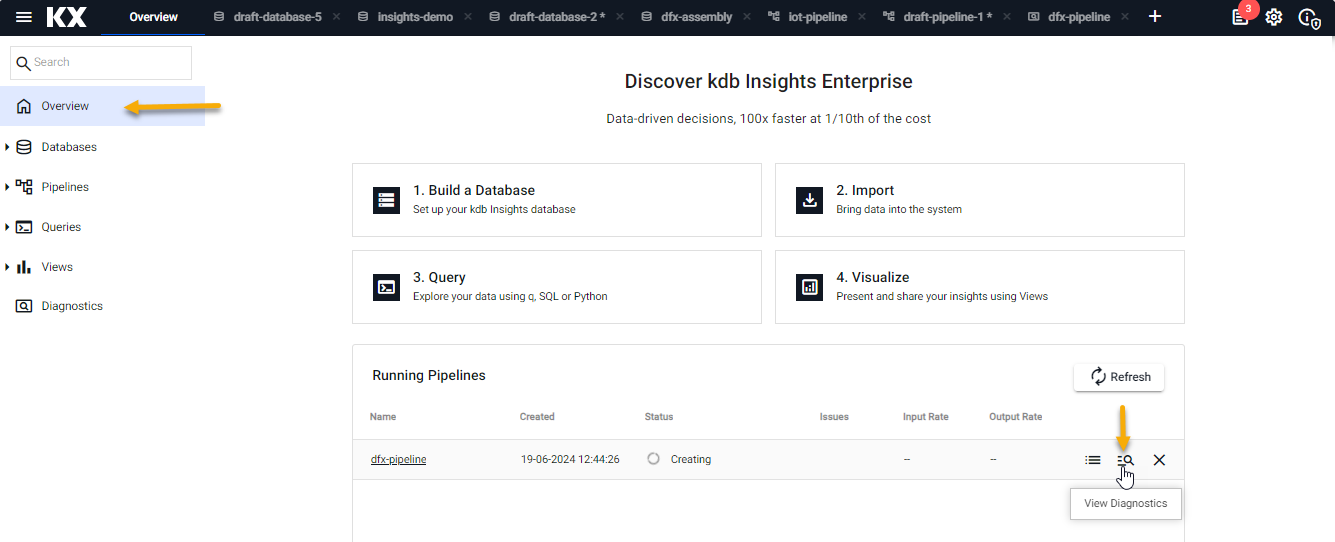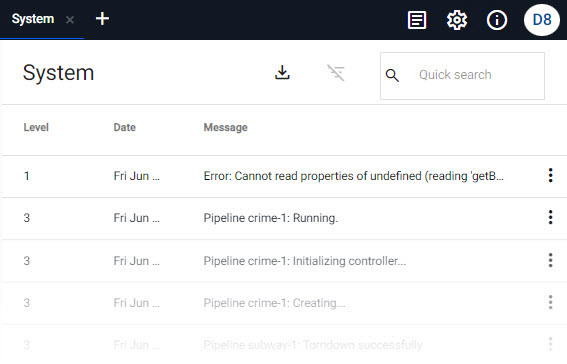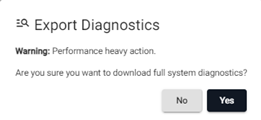Diagnostics
This section describes how to troubleshoot database, pipeline and system errors with Diagnostics, accessed through the kdb Insights Enterprise UI.
This page describes how to:
- Access diagnostics
- View diagnostic events and application logs
- View system notifications
- Access system log level reports
- Setup keycloak diagnostics permissions
Access Diagnostics
There are a few ways to access diagnostics information.
-
Click Diagnostics in the left-hand-side bar to open the Diagnostics screen.

Permissions
Ensure you have the appropriate Keycloak role permissions, otherwise the Diagnostics option is not displayed.
This screen has a search box and 2 dropdowns. Use these to select the database or pipeline that you want to troubleshoot.
Expand either the Databases or Pipelines dropdowns and select a database or pipeline. Alternatively, type the name in the search box. This opens the diagnostics for that entity.
-
You can access Database diagnostics from the Overview tab of the Database screen. Either click the button corresponding to the reported event (Fatal, Error, Warning), or click View all Logs.

-
You can access Pipeline diagnostics by clicking the View Diagnostics icon for a selected Pipeline in the Running Pipelines of the Overview page.

You can now view either Application Logs or Diagnostic Events for the selected Database or Pipeline.
Application Logs
The Application Logs tab displays logs generated by a database or pipeline deployment. Results are paged and can be exported, refreshed, searched, and sorted.
-
The logs can be filtered by ticking one of the event options:
- Fatal
- Error
- Warnings
-
When you access these logs from the Database screen, by clicking the event icon, the logs are filtered based on the event selected.
-
Reset the filters by clicking the Reset Column Filters icon.
-
The time since last update is displayed next to the refresh icon for both events and logs.
-
Download a '.json' report of events or logs by clicking the Download Table icon.
-
Refine your results based on a value entered in the Quick Search box.

Diagnostic Events
The Diagnostic Events tab displays reported events generated by a database or pipeline deployment.
- Results are paged.
- Successful events are identified with a green tick.
- Warnings are identified with a yellow tick.
-
The time since last update is displayed next to the refresh icon for both events and logs.
-
Click on a header column to sort and filter.
-
Download a '.json' report of events or logs by clicking the Download Table icon.
-
Refine your results based on a value entered in the Quick Search box.
Diagnostic data is cached; click the refresh icon to update. Alternatively, close and re-open the current tab from the ribbon menu.

System Notifications
To view system notifications:
-
Click the System Notifications icon in the ribbon menu for real-time notifications of events in the current session as shown below.

-
A slider panel of system notifications is displayed. You can filter results with a text search.

-
Click the new tab link for an expanded view of notifications.


System Settings
Click the System Settings icon, in top right-hand corner of the UI screen.

From here you can:
System Log Level
You can set the system log level, from the System Settings screen to one of the following; Trace, Debug, Info, Warn, Error, Fatal.
Export Full System Diagnostics
Downloading a full diagnostic report is a resource heavy process.
- In the System Settings screen click Download Diagnostics.
Before proceeding, a warning is displayed indicating that this is a performance heavy action and asks you to confirm if you want to proceed.

- Click Yes to download a .json file of system notifications.
Ensure you have the appropriate Keycloak permissions to download system diagnostics.
Keycloak permissions
Diagnostics for kdb Insights Enterprise requires the appropriate Keycloak permissions.
- Ensure you are insights.role.viewer as a minimum. This gives permission to view (but not change) all diagnostics.
A Keycloak admin is required to assign diagnostic roles to your user id.
The following roles are available:
| item | description |
|---|---|
insights.monitor.pod.logs.get |
Gives access to logs on the Application Logs tab in the diagnostics view. These logs include kdb Insights Enterprise specific informational messages and are useful for debugging a running system. |
insights.monitor.events.get |
Gives access to the Diagnostics Events tab in the diagnostics view. These logs include Kubernetes specific events and are useful for debugging startup issues. |
insights.monitor.logLevels.getLevels |
Allows for access to view the log levels in the level selector drop down, in System Settings. |
insights.monitor.logLevels.set |
Allows you to change the log level across all kdb Insights Enterprise components from the Application Log Level drop down. |
insights.monitor.logLevels.get |
When opening the diagnostics view, this provides access to view the log level that is currently set by in the "Application Log Level" drop down. |
insights.monitor.diagnostics.get |
Allows you to download the diagnostics report from your system. |
Changing log levels as a diagnostic viewer
If you are an insights.role.viewer for diagnostics, you must also be an insights.role.reporter if you wish to change the log level.
For more on assigning roles in Keycloak for kdb Insights Enterprise, refer to Authentication and authorization.